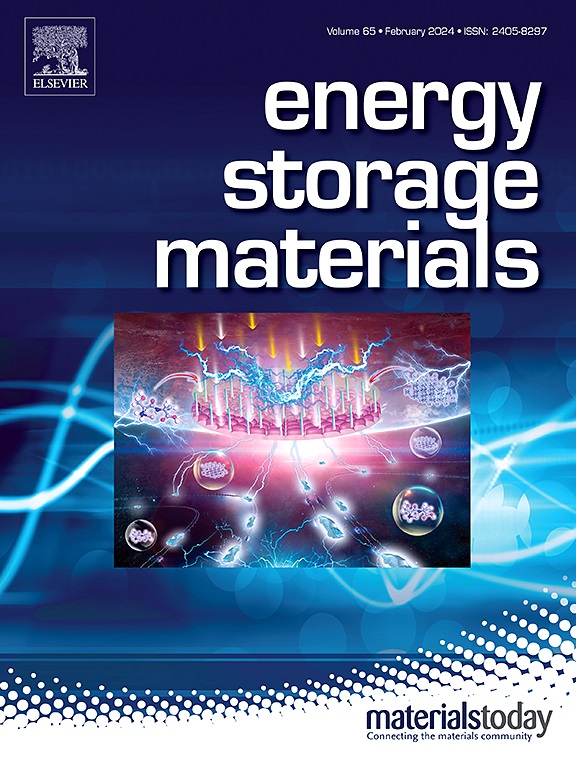用于伪装可穿戴电致变色超级电容器器件的具有构象锁定的三维导电聚噻吩网络的工程设计
IF 18.9
1区 材料科学
Q1 CHEMISTRY, PHYSICAL
引用次数: 0
摘要
电致变色超级电容器(EC-SC)设备展示了未来智能技术的重大前景,将动态可调光电特性与高效储能无缝结合,以满足可持续和能源智能系统的新兴需求。然而,无法在单一材料中协同改善电致变色和电容性能阻碍了其实际应用。在这里,我们开发了一种构象锁设计策略,通过分子内非共价相互作用和分子间氢键引入3D导电网络来制备高性能EC-SC材料。合成的ecsc材料聚(5,7-二(4-氟噻吩-2-基)-2,3-二氢噻吩[3,4-b][1,4]二恶辛)(PFTDT)具有良好的电致变色性能(930 nm下光学对比度为79%),显着的比电容(348 F -1, 1 A g-1)和强大的光/电双稳定性。利用PFTDT优越的多功能特性,我们进一步设计了基于PFTDT的柔性电致变色超级电容器器件(FESDs),用于伪装能量供应。这种fesd表现出多种颜色变化,以及优异的抗机械弯曲稳定性,这使得它们在沙漠、森林和海洋等场景中应用前景广阔。构象锁设计策略和由此产生的高性能PFTDT材料在推进可靠的FESD方面表现出了巨大的希望,其潜在的应用范围可以扩展到各种场景,包括可穿戴电子产品。本文章由计算机程序翻译,如有差异,请以英文原文为准。

Engineering a 3D conductive polythiophene network with conformational locking for camouflaged wearable electrochromic-supercapacitor devices
Electrochromic-supercapacitor (EC-SC) devices demonstrate significant promise for future intelligent technologies, seamlessly combining dynamically adjustable optoelectronic characteristics with high-efficiency energy storage to address emerging demands in sustainable and energy-smart systems. However, the inability to synergistically improve electrochromic and capacitive properties in a single material has prevented its practical application. Here, we develop a conformational lock design strategy to prepare high-performance EC-SC materials by introducing 3D conductive networks through intramolecular noncovalent interactions and intermolecular hydrogen bonding. The synthesized EC-SC material poly(5,7-bis(4-fluorothiophen-2-yl)-2,3-dihydrothieno[3,4-b][1,4]dioxine) (PFTDT) demonstrates concurrent multifunctionality with favorable electrochromic property (79 % optical contrast at 930 nm), remarkable specific capacitance (348 F g-1, 1 A g-1), and robust optical/electrical bistability. Capitalizing on the superior multifunctional properties of PFTDT, we further engineer its-based flexible electrochromic-supercapacitor devices (FESDs) for camouflage energy supply. Such FESDs exhibit multi-color changes, as well as excellent stability against mechanical bending, which makes them promising for applications in scenes such as deserts, forests, and oceans. The conformational lock design strategy and the resulting high-performance PFTDT materials show significant promise for advancing reliable FESD, with potential applications extending to diverse scenarios, including wearable electronics.
求助全文
通过发布文献求助,成功后即可免费获取论文全文。
去求助
来源期刊

Energy Storage Materials
Materials Science-General Materials Science
CiteScore
33.00
自引率
5.90%
发文量
652
审稿时长
27 days
期刊介绍:
Energy Storage Materials is a global interdisciplinary journal dedicated to sharing scientific and technological advancements in materials and devices for advanced energy storage and related energy conversion, such as in metal-O2 batteries. The journal features comprehensive research articles, including full papers and short communications, as well as authoritative feature articles and reviews by leading experts in the field.
Energy Storage Materials covers a wide range of topics, including the synthesis, fabrication, structure, properties, performance, and technological applications of energy storage materials. Additionally, the journal explores strategies, policies, and developments in the field of energy storage materials and devices for sustainable energy.
Published papers are selected based on their scientific and technological significance, their ability to provide valuable new knowledge, and their relevance to the international research community.
 求助内容:
求助内容: 应助结果提醒方式:
应助结果提醒方式:


